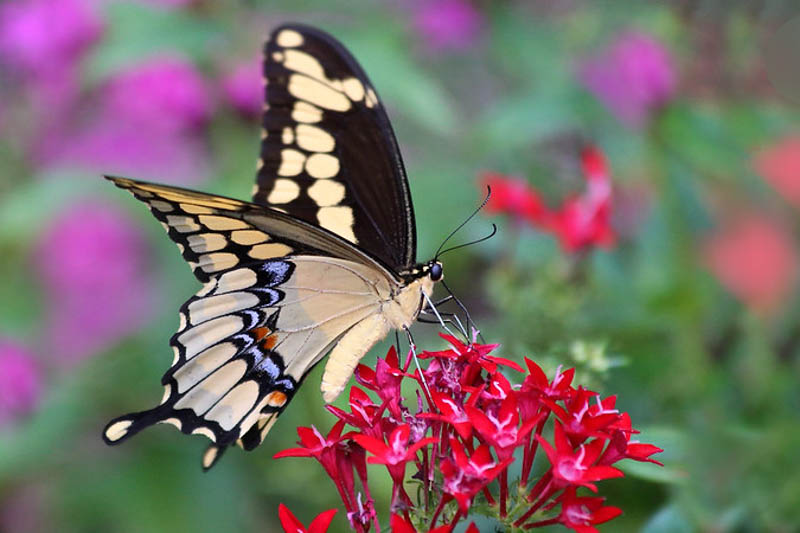A blooming marvel with star-shaped flowers, Pentas are a magnet for butterflies and hummingbirds, adding vibrance to gardens and containers.
Pentas, also known as star cluster or Egyptian star flower, are cherished for their star-shaped flowers that cluster into vibrant, rounded bouquets. With a bushy, upright demeanor, these plants add a splash of persistent color to any landscape. Pentas rank as a top choice among tropical flowers for enthusiasts and gardeners.
Native: Originating in Africa and the Arabian Peninsula, Pentas have adapted to a wide range of tropical and subtropical environments.
Description: Pentas boast lush green foliage and clusters of five-petaled flowers that resemble stars, spanning a spectrum from white to deep red. These hardy plants stand upright, with robust stems and a bushy habit, making them a visually appealing and vibrant addition to any garden space.
Growth Habit: This perennial is herbaceous in habit, offering a woody base with soft, green stems above. It tends to grow upright and can be cultivated as an annual in temperate zones.
Size: Typically, Pentas reach heights of 1 to 3 feet (30-90 cm) with a spread equally as wide, forming a lush, mounded shape.
Flowers: The starry flowers come in shades of white, pink, red, and purple. Each cluster can be a beacon for pollinators. Pentas bloom profusely, especially in warm climates, from early summer through early fall, and in some tropical regions, they may bloom year-round.
 Giant Swallowtail on Red Pentas
Giant Swallowtail on Red Pentas
Foliage: Its leaves are lance-shaped, medium green, and sometimes with a slightly fuzzy texture, which adds to the plant’s tactile appeal.
Hardiness: Pentas are hardy in USDA zones 10-11 but are commonly grown as annuals in cooler regions.
Uses: Primarily used for ornamental purposes, Pentas are excellent for borders, bedding, and container gardening. They are also used as cut flowers due to their long-lasting color.
Pollinators: The flowers are a magnet for bees, butterflies, and hummingbirds, enhancing the ecological value of a garden.
Toxicity: These plants are not known to be toxic to humans or pets, making them a safe choice for varied garden settings.
Deer and Rabbit: Pentas are somewhat resistant to deer and rabbits, though not immune to browsing if food is scarce.
Drought: While Pentas prefer consistent moisture, they are somewhat drought-tolerant once established.
Invasiveness: Pentas are not considered invasive and are easy to manage in a garden setting.
| Hardiness |
10 - 11 |
|---|---|
| Heat Zones |
1 - 11 |
| Climate Zones | 23, 24, H1, H2 |
| Plant Type | Annuals, Houseplants, Perennials |
| Plant Family | Rubiaceae |
| Genus | Pentas |
| Exposure | Full Sun, Partial Sun |
| Season of Interest |
Spring (Early, Mid, Late) Summer (Early, Mid, Late) Fall Winter |
| Height |
1' - 3' (30cm - 90cm) |
| Spread |
1' - 3' (30cm - 90cm) |
| Maintenance | Low |
| Water Needs | Average |
| Soil Type | Loam, Chalk, Sand, Clay |
| Soil pH | Acid, Neutral, Alkaline |
| Soil Drainage | Well-Drained, Moist but Well-Drained |
| Characteristics | Showy, Evergreen, Cut Flowers |
| Attracts | Bees, Butterflies, Hummingbirds |
| Landscaping Ideas | Patio And Containers, Beds And Borders |
| Garden Styles | City and Courtyard, Informal and Cottage, Mediterranean Garden |
| Hardiness |
10 - 11 |
|---|---|
| Heat Zones |
1 - 11 |
| Climate Zones | 23, 24, H1, H2 |
| Plant Type | Annuals, Houseplants, Perennials |
| Plant Family | Rubiaceae |
| Genus | Pentas |
| Exposure | Full Sun, Partial Sun |
| Season of Interest |
Spring (Early, Mid, Late) Summer (Early, Mid, Late) Fall Winter |
| Height |
1' - 3' (30cm - 90cm) |
| Spread |
1' - 3' (30cm - 90cm) |
| Maintenance | Low |
| Water Needs | Average |
| Soil Type | Loam, Chalk, Sand, Clay |
| Soil pH | Acid, Neutral, Alkaline |
| Soil Drainage | Well-Drained, Moist but Well-Drained |
| Characteristics | Showy, Evergreen, Cut Flowers |
| Attracts | Bees, Butterflies, Hummingbirds |
| Landscaping Ideas | Patio And Containers, Beds And Borders |
| Garden Styles | City and Courtyard, Informal and Cottage, Mediterranean Garden |
Create a membership account to save your garden designs and to view them on any device.
Becoming a contributing member of Gardenia is easy and can be done in just a few minutes. If you provide us with your name, email address and the payment of a modest $25 annual membership fee, you will become a full member, enabling you to design and save up to 25 of your garden design ideas.
Join now and start creating your dream garden!
Create a membership account to save your garden designs and to view them on any device.
Becoming a contributing member of Gardenia is easy and can be done in just a few minutes. If you provide us with your name, email address and the payment of a modest $25 annual membership fee, you will become a full member, enabling you to design and save up to 25 of your garden design ideas.
Join now and start creating your dream garden!